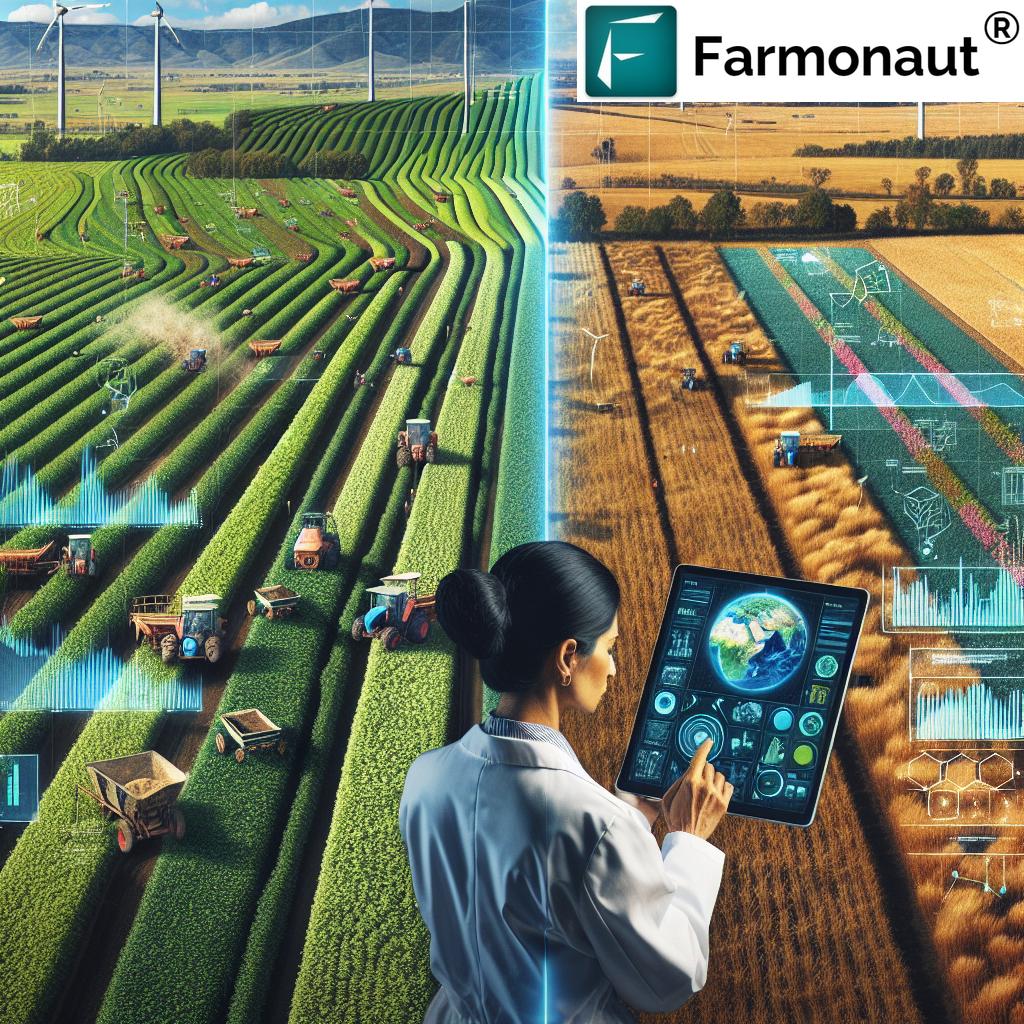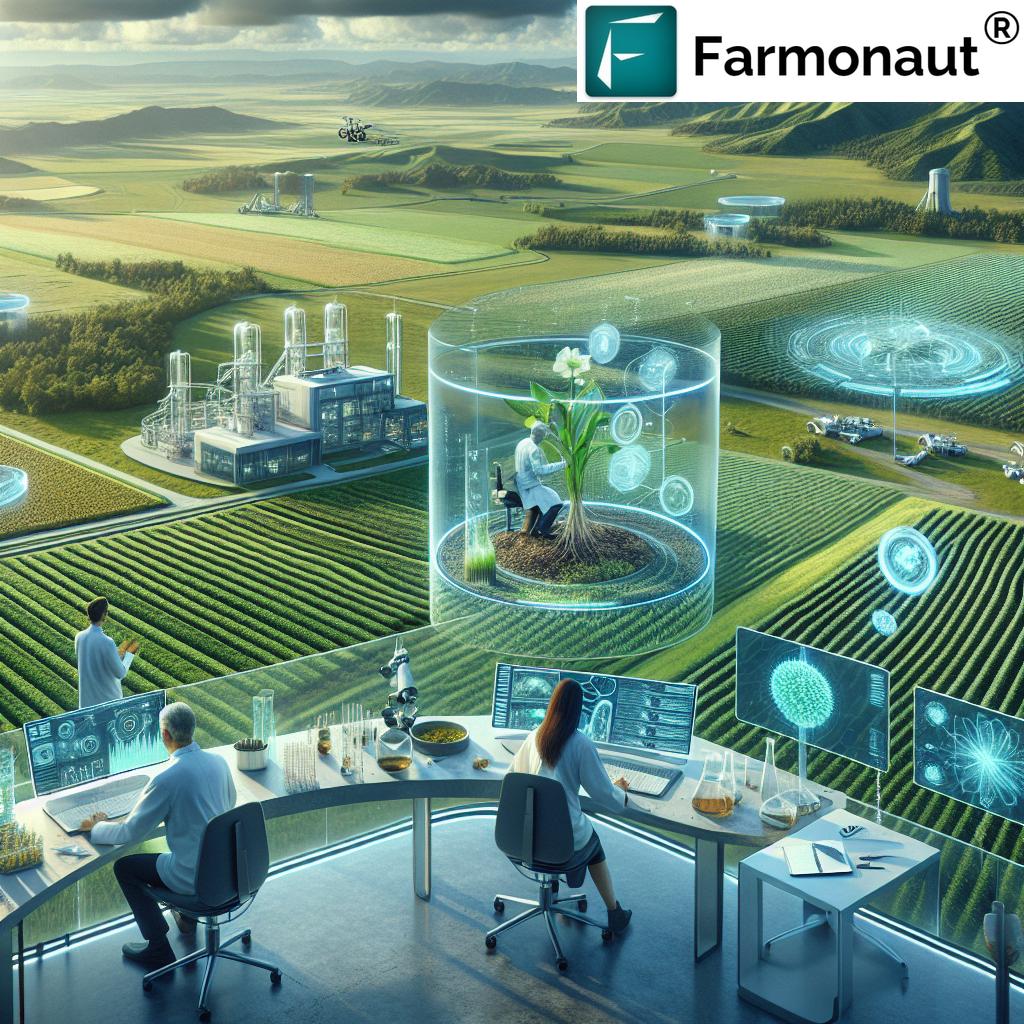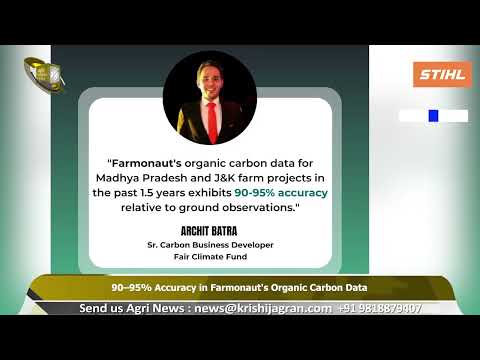Revolutionizing American Agriculture: How Precision Farming and Remote Sensing are Shaping Sustainable Land Management
“Remote sensing technologies have increased crop yield predictions accuracy by up to 90% in some American farms.”
In the heartland of America, a quiet revolution is taking place. The fields that have long been the backbone of our nation’s agricultural prowess are undergoing a transformation, driven by cutting-edge technology and a commitment to sustainable practices. At Farmonaut, we’re at the forefront of this revolution, leveraging precision farming and remote sensing to reshape the landscape of American agriculture.

As we delve into the world of modern agronomy, we’ll explore how these advancements are not just improving yields but also promoting sustainable land management practices that will ensure the longevity of our agricultural resources for generations to come.
The Evolution of American Agriculture
American agriculture has come a long way from the days of horse-drawn plows and manual harvesting. Today, our fields are managed with sophisticated technology that would have seemed like science fiction to our grandparents. This evolution is not just about convenience; it’s a necessary response to the growing challenges faced by modern farmers:
- Increasing global food demand
- Climate change and extreme weather events
- Soil degradation and resource scarcity
- Economic pressures and market volatility
To address these challenges, we’ve turned to precision farming and remote sensing technologies. These tools allow us to make data-driven decisions that optimize crop yields while minimizing environmental impact.
The Role of Precision Farming in Sustainable Agriculture
Precision farming is revolutionizing the way we approach crop production. By utilizing advanced technologies, we can now manage fields with a level of accuracy and efficiency that was previously unimaginable. Here’s how precision farming is making a difference:
- Resource Optimization: Precision farming allows for the targeted application of water, fertilizers, and pesticides, reducing waste and environmental impact.
- Improved Crop Health: Early detection of crop stress and disease through remote sensing enables timely interventions.
- Increased Yields: By optimizing growing conditions, farmers can significantly increase their crop yields.
- Reduced Environmental Footprint: Efficient use of resources leads to a smaller carbon footprint and less soil degradation.
At Farmonaut, we’re proud to offer cutting-edge precision farming tools that empower farmers to make informed decisions. Our satellite-based crop health monitoring system provides real-time insights into vegetation health, soil moisture levels, and other critical metrics.
Remote Sensing: The Eyes in the Sky
Remote sensing has become an indispensable tool in modern agriculture. By utilizing satellite imagery and other aerial data collection methods, we can gather vast amounts of information about our crops and land without ever setting foot in the field. This technology offers several advantages:
- Wide Coverage: Satellites can monitor large areas of land simultaneously, providing a comprehensive view of agricultural regions.
- Frequent Updates: Regular satellite passes allow for continuous monitoring of crop development throughout the growing season.
- Multiple Data Types: Multispectral imagery provides insights into various aspects of crop and soil health.
- Weather-Independent: Satellite data can be collected regardless of local weather conditions, ensuring consistent monitoring.
Our Farmonaut platform leverages advanced satellite imagery to provide farmers with actionable insights. By analyzing multispectral data, we can detect early signs of crop stress, predict yields, and optimize irrigation schedules.
Soil Science and Agronomy: The Foundation of Sustainable Farming
At the heart of sustainable agriculture lies a deep understanding of soil science and agronomy. These disciplines form the foundation upon which we build our precision farming practices. Here’s why they’re so crucial:
- Soil Health: Healthy soils are the bedrock of productive agriculture. By understanding soil composition, structure, and biology, we can implement practices that maintain and improve soil health.
- Nutrient Management: Proper nutrient management ensures that crops receive the right nutrients at the right time, maximizing yields while minimizing environmental impact.
- Water Conservation: Soil science helps us understand water retention and movement, allowing for more efficient irrigation practices.
- Carbon Sequestration: Healthy soils can act as carbon sinks, helping to mitigate climate change.
Our Farmonaut platform integrates advanced soil science principles with remote sensing data to provide comprehensive soil health assessments. This allows farmers to make informed decisions about soil management practices.
Explore Farmonaut’s API for advanced soil and crop data analysis
The Impact of Climate Change on American Agriculture
Climate change poses significant challenges to American agriculture, but it also presents opportunities for innovation. As we face more frequent extreme weather events and shifting growing seasons, precision farming and remote sensing technologies become even more critical. Here’s how we’re adapting:
- Climate-Resilient Crop Selection: Using historical and predictive climate data to choose crops best suited for changing conditions.
- Drought Management: Implementing water-conserving irrigation techniques based on real-time soil moisture data.
- Pest and Disease Monitoring: Utilizing remote sensing to detect and respond to new pest and disease pressures brought on by changing climates.
- Carbon Footprint Reduction: Employing precision agriculture techniques to minimize greenhouse gas emissions from farming activities.
At Farmonaut, we’re committed to helping farmers navigate the challenges of climate change. Our platform includes features for carbon footprint tracking and AI-driven advisory systems that take climate projections into account.
“Precision agriculture techniques can reduce water usage in farming by up to 30%, promoting sustainable land management practices.”
Sustainable Land Management Practices
Sustainable land management is no longer just an ideal; it’s a necessity for the future of American agriculture. By combining traditional wisdom with modern technology, we can implement practices that protect our soil, water, and air while maintaining high productivity. Some key sustainable practices include:
- Conservation Tillage: Reducing soil disturbance to prevent erosion and improve soil structure.
- Cover Cropping: Planting crops to protect and enrich the soil during off-seasons.
- Precision Nutrient Management: Applying fertilizers only where and when they’re needed, based on soil and crop data.
- Integrated Pest Management: Using a combination of biological, cultural, and chemical methods to control pests while minimizing environmental impact.
Our Farmonaut platform supports these practices by providing detailed, field-specific data that allows farmers to implement sustainable techniques with precision and confidence.
Learn more about integrating sustainable practices with our API Developer Docs

The Future of Crop Nutrition Management
As we look to the future, crop nutrition management is becoming increasingly sophisticated. Gone are the days of blanket fertilizer applications. Today, we’re moving towards a future where every plant receives exactly what it needs, when it needs it. This approach is made possible by:
- Real-Time Soil Testing: In-field sensors that provide continuous data on soil nutrient levels.
- Variable Rate Technology: Equipment that can adjust fertilizer application rates on-the-go based on soil and crop needs.
- Predictive Analytics: AI-powered systems that forecast crop nutrient requirements based on growth stage, weather conditions, and historical data.
- Biofortification: Developing crops with enhanced nutritional profiles to address global malnutrition challenges.
At Farmonaut, we’re at the forefront of this revolution in crop nutrition management. Our Jeevn AI Advisory System combines satellite data with advanced analytics to provide personalized nutrition recommendations for each field.
Water Conservation in Agriculture: A Critical Challenge
Water scarcity is becoming an increasingly pressing issue for American agriculture. As climate change alters precipitation patterns and depletes groundwater resources, efficient water use is more important than ever. Precision farming and remote sensing technologies are playing a crucial role in water conservation:
- Soil Moisture Monitoring: Using sensors and satellite data to track soil moisture levels and optimize irrigation timing.
- Precision Irrigation Systems: Implementing drip irrigation and variable rate sprinklers that apply water only where it’s needed.
- Drought-Resistant Crop Varieties: Developing and selecting crops that can thrive with less water.
- Water Harvesting Techniques: Implementing systems to capture and store rainwater for use during dry periods.
Our Farmonaut platform includes advanced water management tools that help farmers make the most of every drop. By combining weather forecasts with real-time soil moisture data, we can provide precise irrigation recommendations that conserve water without compromising crop health.
The Role of Federal Agencies and Agricultural Policy
The adoption of precision farming and sustainable land management practices is not just a matter of individual choice; it’s also influenced by federal policies and initiatives. Several key agencies play a role in shaping the future of American agriculture:
- USDA (United States Department of Agriculture): Provides funding for research and implementation of sustainable farming practices.
- EPA (Environmental Protection Agency): Regulates the use of pesticides and sets standards for water quality in agricultural areas.
- NRCS (Natural Resources Conservation Service): Offers technical assistance and financial support for conservation efforts on private lands.
- Farm Bill: This comprehensive piece of legislation sets the stage for agricultural and food policy, including support for precision agriculture and conservation programs.
As advocates for sustainable agriculture, we at Farmonaut stay informed about policy developments and work to ensure that our technologies align with and support federal initiatives for sustainable land management.
Education and Career Development in Soil Science
The future of sustainable agriculture depends on a skilled workforce that understands both traditional farming practices and cutting-edge technologies. Education and career development in soil science and agronomy are crucial for the continued advancement of our field. Here are some key aspects:
- Undergraduate Programs: Universities across America are offering specialized degrees in precision agriculture and sustainable farming practices.
- Graduate Research: Advanced studies are pushing the boundaries of what’s possible in agricultural technology and sustainability.
- Professional Certifications: Organizations like the Soil Science Society of America offer certifications that validate expertise in soil science and land management.
- Continuing Education: Webinars, online courses, and workshops help professionals stay up-to-date with the latest advancements in the field.
At Farmonaut, we’re committed to supporting education in agricultural sciences. We offer internships and collaborate with academic institutions to bridge the gap between theoretical knowledge and practical application in the field.
Research Funding and Innovation in Agronomy
The rapid advancements in precision farming and remote sensing are fueled by ongoing research and innovation. Funding for agricultural research comes from various sources and supports a wide range of initiatives:
- Government Grants: Federal and state agencies provide significant funding for agricultural research through competitive grant programs.
- Private Sector Investment: Agribusiness companies invest in R&D to develop new technologies and improve existing ones.
- Non-Profit Organizations: Foundations and NGOs support research aimed at sustainable agriculture and food security.
- Academic-Industry Partnerships: Collaborations between universities and companies drive innovation in applied agricultural science.
As a technology company deeply involved in agricultural innovation, we at Farmonaut actively participate in research initiatives and stay abreast of the latest findings in agronomy and remote sensing.
The Global Impact of American Agricultural Innovation
The advancements in precision farming and sustainable land management practices in America have far-reaching implications for global agriculture. As we develop and refine these technologies, we’re also contributing to solutions for global challenges:
- Food Security: Increased productivity and resilience in American agriculture help stabilize global food supplies.
- Technology Transfer: Innovations developed in the U.S. can be adapted and implemented in other countries, improving agricultural practices worldwide.
- Climate Change Mitigation: Sustainable farming practices contribute to global efforts to reduce greenhouse gas emissions and sequester carbon.
- Water Conservation: Efficient water use techniques developed for American farms can be applied in water-stressed regions around the world.
At Farmonaut, we’re proud to be part of this global movement towards more sustainable and efficient agriculture. Our technologies are designed with global applicability in mind, recognizing that the challenges faced by American farmers are often shared by their counterparts around the world.
Precision Farming Technologies Comparison
| Technology Name | Primary Function | Data Collected | Application in Agriculture | Environmental Benefits | Estimated Cost Range | Adoption Rate (%) |
|---|---|---|---|---|---|---|
| Satellite Imagery | Large-scale crop monitoring | Multispectral imagery, vegetation indices | Crop health assessment, yield prediction | Reduced chemical use, efficient resource allocation | $5,000 – $50,000 per year | 60-70% |
| Drone Mapping | Detailed field analysis | High-resolution imagery, 3D models | Pest detection, plant counting, crop scouting | Targeted pest management, reduced pesticide use | $1,000 – $10,000 per drone | 30-40% |
| Soil Sensors | Real-time soil monitoring | Moisture, temperature, nutrient levels | Irrigation management, fertilizer optimization | Water conservation, reduced nutrient runoff | $100 – $1,000 per sensor | 40-50% |
| GPS-guided Equipment | Precise field operations | Location data, equipment performance | Auto-steering, variable rate application | Reduced fuel consumption, minimized soil compaction | $5,000 – $50,000 per system | 70-80% |
| Weather Stations | Local climate monitoring | Temperature, rainfall, wind speed | Planting timing, frost protection | Improved crop resilience, efficient water use | $1,000 – $5,000 per station | 50-60% |
| Crop Monitoring Systems | Integrated farm management | Combines multiple data sources | Comprehensive farm analytics, decision support | Holistic environmental management | $10,000 – $100,000 per system | 20-30% |
The Future of American Agriculture
As we look to the future, the trajectory of American agriculture is clear: more precise, more sustainable, and more data-driven. The integration of precision farming and remote sensing technologies is not just improving current practices; it’s paving the way for entirely new approaches to agriculture. Some exciting developments on the horizon include:
- AI-Powered Decision Making: Advanced algorithms will analyze complex datasets to provide farmers with actionable insights in real-time.
- Autonomous Farm Equipment: Self-driving tractors and robotic harvesters will become more common, increasing efficiency and reducing labor costs.
- Vertical Farming: Urban agriculture will expand, utilizing precision technologies to grow crops in controlled environments.
- Blockchain in Agriculture: Increased use of blockchain technology will improve traceability and transparency in the food supply chain.
At Farmonaut, we’re excited to be at the forefront of these developments. Our platform is continuously evolving to incorporate new technologies and provide farmers with the tools they need to succeed in the changing agricultural landscape.
Conclusion: Embracing the Agricultural Revolution
The revolution in American agriculture, driven by precision farming and remote sensing technologies, is more than just a technological upgrade—it’s a fundamental shift in how we approach food production and land management. By embracing these advancements, we’re not only improving yields and efficiency but also paving the way for a more sustainable and resilient agricultural future.
At Farmonaut, we’re committed to being a key player in this revolution. Our platform combines cutting-edge technology with a deep understanding of agricultural science to provide farmers with the tools they need to thrive in this new era. From satellite-based crop monitoring to AI-powered advisory systems, we’re working to make precision agriculture accessible and effective for farms of all sizes.
As we move forward, the challenges facing American agriculture—from climate change to resource scarcity—will require continued innovation and adaptation. But with the power of precision farming and remote sensing at our fingertips, we’re well-equipped to meet these challenges head-on. The future of American agriculture is bright, sustainable, and data-driven, and we’re excited to be part of the journey.
FAQs
- What is precision farming?
Precision farming is an agricultural management concept that uses technology to observe, measure, and respond to variability in crops. It allows farmers to optimize returns on inputs while preserving resources. - How does remote sensing benefit agriculture?
Remote sensing provides valuable data on crop health, soil moisture, and other key factors without the need for physical field inspections. This enables more efficient resource management and early problem detection. - What role does AI play in modern agriculture?
AI in agriculture analyzes vast amounts of data from various sources to provide insights and recommendations for farm management, helping to optimize decisions on planting, irrigation, and harvesting. - How does sustainable land management contribute to climate change mitigation?
Sustainable land management practices, such as conservation tillage and cover cropping, help sequester carbon in the soil and reduce greenhouse gas emissions from agricultural activities. - What are the main challenges in adopting precision farming technologies?
The main challenges include initial investment costs, the need for technical expertise, and ensuring data privacy and security. However, the long-term benefits often outweigh these initial hurdles.






